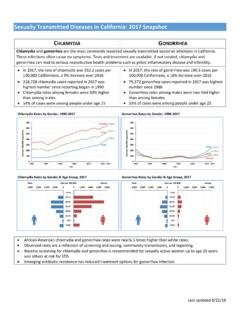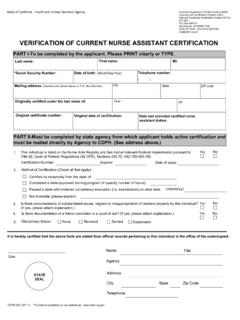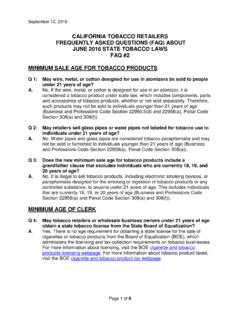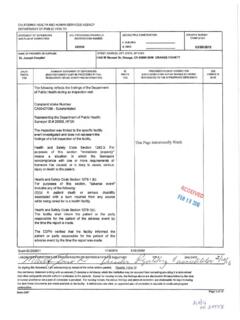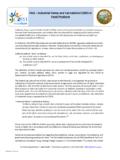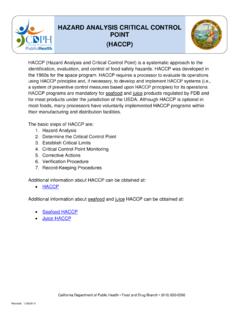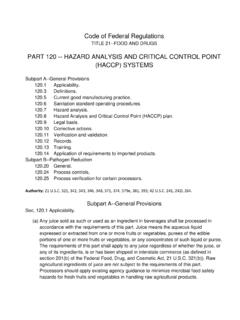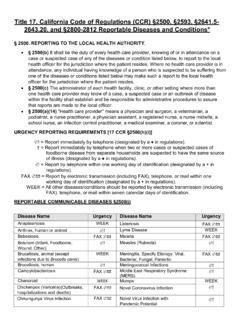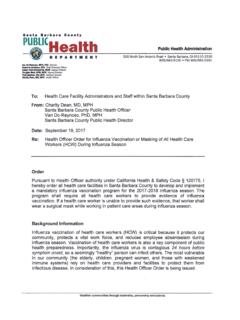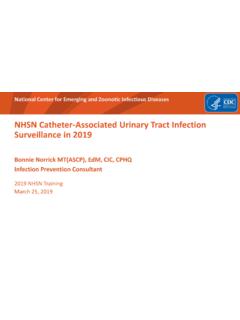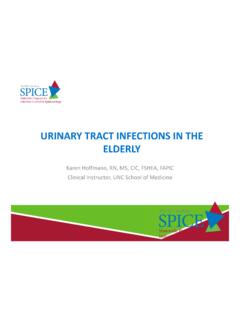Transcription of Catheter-Associated Urinary Tract Infection Prevention
1 HEALTHCARE- associated infections PROGRAMB asics of Infection PreventionHealthcare- associated infections ProgramCenter for Health Care QualityCalifornia Department of Public HealthCatheter- associated Urinary Tract Infection PreventionLast updated 2015 HEALTHCARE- associated infections PROGRAMO bjectives Define the scope of healthcare- associated Urinary Tract infections (UTI) Review evidence-based clinical practices shown to prevent Catheter-Associated Urinary Tract infections (CAUTI) Discuss strategies to reduce CAUTI within healthcare settings Review CAUTI surveillance definitions 2 HEALTHCARE- associated infections PROGRAMUTI Epidemiology Accounts for >30% of all HAI reported to nhsn by hospitals Leading cause of secondary bloodstream Infection (BSI) 10% mortality rate (13,000 attributable deaths annually) Increases length of stay by 2-4 days Results in antimicrobial overuse and antimicrobial resistance3 Gould C.
2 , Catheter-Associated Urinary Tract Infection (CAUTI) Toolkit, CDCS ource: APIC Guide to the Elimination of CAUTI (2008)HEALTHCARE- associated infections PROGRAMU rinary catheter Use Medical surgical unit: 10-30% ICU: 60-90% Nursing home: 5-10% 40-50% of catheters on non-ICU hospital wards do not have a valid indication for use Physicians frequently unaware of use In recent study, >50% did not know which patients were catheterized 75% did not know duration of use or discontinuation4 HEALTHCARE- associated infections PROGRAM Source: Patient s colonic or perineal flora Bacteria on hands of personnel Microbes enter bladder via one of two routes: Extraluminal: around the external surface Intraluminal: inside the catheter Risk of bacteriuria with catheterization Daily: 3% - 10% By day 30: 100%5 CAUTI EtiologyMaki D, TambyahP.
3 , Engineering out risk of Infection with Urinary catheters. EmergInfect Dis, 2001 HEALTHCARE- associated infections PROGRAMP athogens associated with CAUTI E. coli26% Enterococci16% P. aeruginosa12% Candida species9% K. pneumoniae6% Enterobacter species6%Gould C., Catheter-Associated Urinary Tract Infection (CAUTI) Toolkit, CDC 6 HEALTHCARE- associated infections PROGRAMH istorical PerspectiveWhat we did IP typically Reviewed CDC guidelines on Prevention of UTI Educated staff, mainly nursing, on the guidelines Performed surveillance of UTI Reported findings to Infection Control and Executive Committees Reported our success to The Joint Commission 7 HEALTHCARE- associated infections PROGRAMH istorical Perspective -2 And What Happened Many thousands of patients developed hospital-acquired UTIs per year 80% were Urinary Catheter-Associated Approximately half of the patients with a Urinary catheter did not have a valid indication for placement Each day the Urinary catheter remained, the risk of CAUTI increased 5% Gould C.
4 , Catheter-Associated Urinary Tract Infection (CAUTI) Toolkit, CDC 8 HEALTHCARE- associated infections PROGRAMC urrent Perspective on HAI Prevention Consumer awareness of the impact of HAI Costs of healthcare Population with decreased access to medical care Demand for accountability by regulatory agencies, advocacy groups, and legislative mandates Infection Prevention has become a clear mandateIt takes a village(or at least a health care team)to prevent HAI9 HEALTHCARE- associated infections PROGRAMNew Tenets of Infection PreventionIP expectedto Review the evidence-based (CDC) guidelines Evaluate yourfacility s adoption of recommended practices What is actually going on versus what is recommended? Collect data to understand current practice Implement recommended practices Educate staff ---ALL healthcare stakeholders Change patient care practices where necessary Educate patients regarding Infection risks and their role in prevention10 HEALTHCARE- associated infections PROGRAMNew Tenets of Infection Prevention - 2 Perform standardized surveillance for infections Understand the current state Set Prevention target (% reduction goal or elimination)
5 Monitor progress in reducing infections Monitor compliance until the Prevention target has been reached Feedback observational data to all stakeholders Monitor process measures periodically to ensure sustainability of Prevention target outcome measures11 HEALTHCARE- associated infections PROGRAMCAUTI Prevention With currently recommended Infection Prevention practices, estimated up to 69%CAUTI can be prevented 380,000 infections prevented annually 9,000 lives saved National CAUTI 5-year Prevention goal: 25% decrease from 2009 baselineCDC 2009 CAUTI Guideline: ( )HHS Agency HAI: Priority Goal: ( )12 HEALTHCARE- associated infections PROGRAM13 CAUTI Prevention StrategiesHEALTHCARE- associated infections PROGRAMCAUTI CorePrevention Strategies Insert catheters only for appropriate indications Leave in place only as long as needed Only properly trained persons insert and maintain Hand hygiene Aseptic technique and sterile equipment for insertion Maintain closed drainage system and unobstructed urine flow Implement improvement program to achieve appropriate use of cathetersCDC 2009 CAUTI Guideline: ( )14 HEALTHCARE- associated infections PROGRAMCAUTI SupplementalPrevention Strategies Alternatives to indwelling Urinary catheters Portable ultrasound devices to assess Urinary retention, reduce unnecessary catheterizations Antimicrobial/antiseptic impregnated cathetersCDC 2009 CAUTI Guideline.
6 ( )15 HEALTHCARE- associated infections PROGRAMUse Indwelling Urinary Catheters for Appropriate Indications Acute Urinary retention or obstruction Peri-operative use in selected surgeries Assist healing of perineal and sacral wounds in incontinent patients Hospice, comfort care, palliative care Required immobilization for trauma or surgery Chronic indwelling Urinary catheter on admission Accurate measurement of Urinary output in critically ill patients (intensive care)CDC 2009 CAUTI Guideline: ( infections PROGRAMCAUTI Insertion Bundle Verify need prior to insertion Insert Urinary catheter using aseptic technique. Maintain Urinary catheter based on recommended guidelinesCAUTI Maintenance Bundle Daily assessment and documented need for catheter Tamper evident seal is intact catheter secured with securement device Hand hygiene performed before patient contact Daily meatal hygiene with soap and water Drainage bag emptied using a clean container Unobstructed flow CAUTI: A patient-centered approach.)
7 (Autumn 2012) APIC Prevention strategist: ( )HEALTHCARE- associated infections PROGRAMNot RecommendedNo evidence to support an effect on UTI Prevention Complex Urinary drainage systems Routinely changing catheters or drainage bags Routine antimicrobial prophylaxis Cleaning the periurethral area with antiseptics Antimicrobial irrigation of the bladder Antiseptic / antimicrobial solution instillation into drainage bags Routine screening for asymptomatic bacteriuriaGould C., Catheter-Associated Urinary Tract Infection (CAUTI) Toolkit, CDC 18 HEALTHCARE- associated infections PROGRAMUTI Prevention Process Measures Measure HCW compliance using one or more of the following: Hand hygiene Documentation of catheter insertion and removal Daily assessment of foley catheter Documentation of indications for useGould C., Catheter-Associated Urinary Tract Infection (CAUTI) Toolkit, CDC 19 HEALTHCARE- associated infections PROGRAMUTI Prevention Outcome Measure Perform UTI surveillance using standardized definitions and protocols Note: Bacteria isolated from urine alone does NOTmeet surveillance definitions for UTI Example:If a culture grows >100,000 (105) CFU/ml, the patient must have symptoms described in the nhsn protocol.
8 nhsn Patient Safety Module: Chapter 7 Device- associated Module: CAUTI20 HEALTHCARE- associated infections PROGRAMCAUTI SurveillanceUTI may or may not be associated with use of a Urinary catheter (CAUTI vs. UTI) For CAUTI: catheter must be in place >2 days (Day 1= day of insertion) nhsn Patient Safety Module: Chapter 7 Device- associated Module: CAUTI21 catheter still presentOrCatheter removed day of or day prior to when UTI criteria metAndHEALTHCARE- associated infections PROGRAMCAUTI Surveillance - continued nhsn Infection window period: seven days during which all site-specific Infection criteria must be met Criteria for CAUTI include specific clinical symptoms and positive urine culture, and sometimes positive blood culture Includes the day the firstpositive diagnostic test (urine culture or blood culture for CAUTI) was obtained, 3 calendar days beforeand 3 calendar days afterNHSN Patient Safety Module: Chapter 7 Device- associated Module.
9 CAUTI22 HEALTHCARE- associated infections PROGRAMCAUTI Infection Window Period- Acute Care Facilities23 For CAUTI, the first diagnostic test will be either a positive urine or blood cultureHEALTHCARE- associated infections PROGRAMCAUTID iagnostic Test Positive urine or blood cultureExamples of Localized Signs and Symptoms Suprapubic tenderness Costovertebral angle pain Urgency Frequency Dysuria Fever24 CAUTI Infection Criteria- Acute Care HospitalsNHSN Patient Safety Module: Chapter 7 Device-AssociatedHEALTHCARE- associated infections PROGRAMCAUTI Cannot Re-Occur in the Same Patient Within a 14-Day PeriodNo new CAUTI can be reported within a 14-day repeat Infection timeframe The date of the CAUTI event is considered day 1 A new CAUTI is not reported until 14 days have elapsed If a new pathogen is identified in the urine within the 14-day period it should be added to the CAUTI already reported Refer to the CAUTI protocol for more details nhsn Patient Safety Module: Chapter 7 Device- associated Module.
10 CAUTI25 HEALTHCARE- associated infections PROGRAMCAUTI Location Attribution Attribute CAUTI to the inpatient location where the patient was assigned on the date of Infection event If all elements of CAUTI are present on the date of transfer or discharge, or the next day, the CAUTI is attributed to the transferring/discharging locationNHSN Patient Safety Module: Chapter 7 Device- associated Module: CAUTI26 HEALTHCARE- associated infections PROGRAMS ymptomatic CAUTI Surveillance DefinitionSymptomatic CAUTI requires the patient to have bothclinical and microbiologic findings within a 7-day window period Refer to written definitions frequently when performing UTI surveillance Clinical symptom criteria differ for patients with current indwelling catheters versus catheters removed day prior versus no exposure to catheter . Urine culture must grow no more than two species of organisms, at least one of which is bacteriaof >105 CFU/mlNHSN Patient Safety Module: Chapter 7 Device- associated Module: CAUTI27 HEALTHCARE- associated infections PROGRAMA symptomatic CAUTI with Bacteremia Surveillance Definition Asymptomatic UTI with Bacteremia (ABUTI) requires the following threecriteria within a 7-day window period: Urine culture with no more than two species of organisms, at least one of which is a bacteria of >105 CFU/ml Positive blood culture with at least one matching bacteria to the urine or2 positive blood cultures with common commensal bacteria and a matching common commensal in the urine No clinical signs or symptoms of CAUTINHSN Patient Safety Module: Chapter 7 Device- associated Module.
